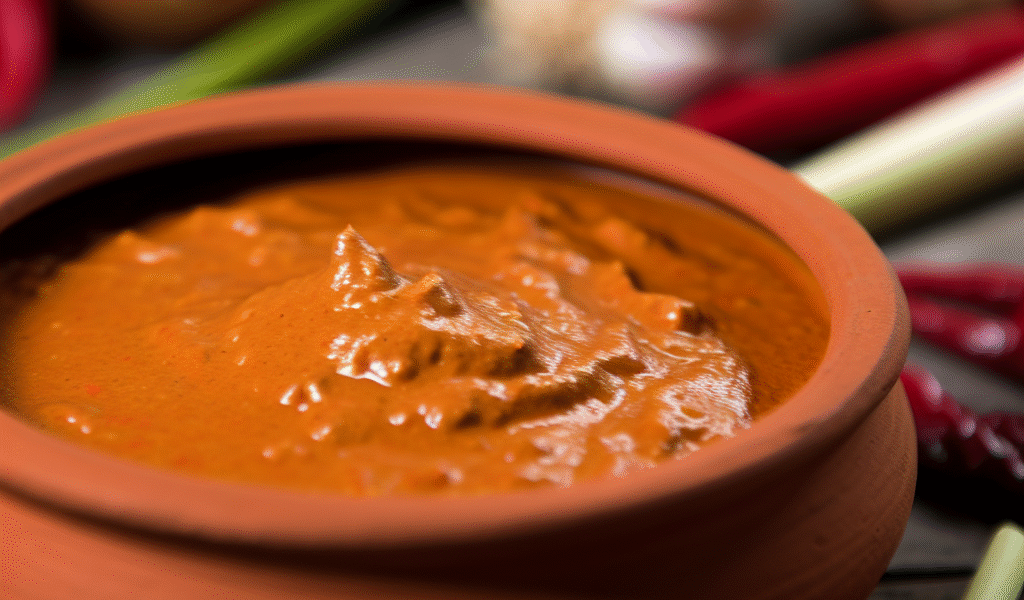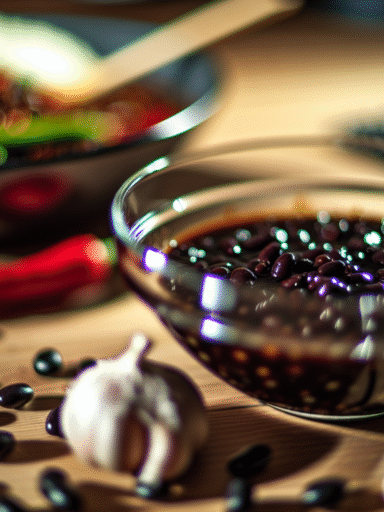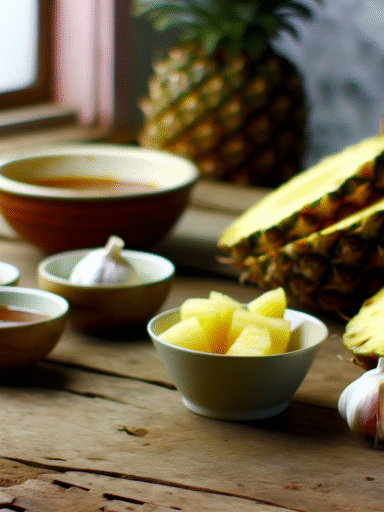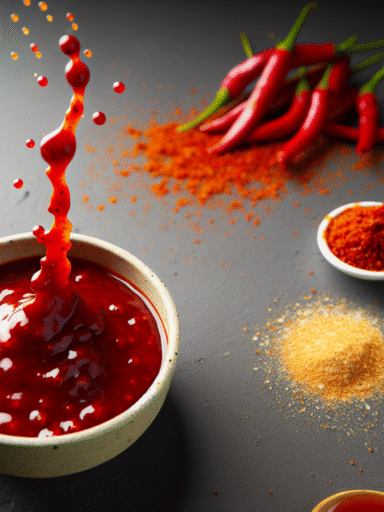Thai Red Curry Sauce
Thai Red Curry Sauce is a vibrant and aromatic base that embodies the heart of Thailand’s bold cuisine. Packed with fragrant herbs, creamy coconut milk, and just the right kick of heat, this sauce not only brings dishes to life but also fills your kitchen with irresistible aromas. Whether you’re new to Thai cooking or a seasoned home chef, nailing this sauce is a game changer.
Tags / Categories
- Flavor Profile: Spicy, aromatic, creamy, slightly sweet
- Main Ingredients: Red chilies, coconut milk, lemongrass, garlic, galangal
- Region: Thailand, Central Thai cuisine
- Usage: Curries, marinades, stir-fries, soups
Quick Info Box
- Prep Time: 10 minutes
- Cook Time: 15 minutes
- Total Time: 25 minutes
- Difficulty Level: Intermediate
- Yield: Approximately 1 ½ cups (enough for 4 servings)
Ingredients List
- 10 dried red chilies, soaked in warm water for 15 minutes
- 2 fresh red chilies, chopped (optional for extra heat)
- 3 shallots, peeled and quartered
- 4 cloves garlic, smashed
- 1 thumb-sized piece fresh galangal, peeled and sliced
- 1 stalk lemongrass, white part only, finely chopped
- 1 tsp coriander seeds, toasted
- 1 tsp cumin seeds, toasted
- 1 tsp shrimp paste (optional; substitute with miso for vegetarian)
- 1 tbsp vegetable oil or coconut oil
- 1 ½ cups coconut milk (full fat preferred for richness)
- 1 tbsp fish sauce (or soy sauce for vegetarian)
- 1 tsp palm sugar or brown sugar
- Fresh Thai basil or cilantro for garnish (optional)
Crafting the Perfect Thai Red Curry Sauce
To build the classic Thai red curry sauce, start by revitalizing those dried chilies in warm water, softening their heat and flavor. While they soak, gather your fresh herbs and spices — it’s like gathering ingredients for a fragrant adventure. Toasting your coriander and cumin seeds awakens their earthy aromas, so don’t skip this step; your kitchen will smell amazing right about now.
Once your ingredients are ready, add the softened dried chilies, fresh chilies, shallots, garlic, galangal, lemongrass, coriander, cumin, and shrimp paste into a mortar and pestle or food processor. Grind or blend everything into a thick, fragrant paste — don’t stress if it’s a little chunky; it adds character and texture. If you like it smoother, a quick blitz will do.
Next, heat the oil in a pan over medium heat, and gently fry the curry paste until it becomes aromatic and slightly darker — about 3 to 5 minutes. This step is crucial, as it deepens the flavors and mellows out the raw edges of those fresh ingredients.
Finally, slowly stir in your creamy coconut milk, fish sauce, and palm sugar. Let it simmer lightly for 10 minutes, stirring occasionally so the sauce thickens and all the flavors meld together beautifully. Taste and adjust seasoning as you go — if you want it spicier, more fish sauce, or a touch more sugar, trust your tastebuds. That’s the fun of homemade sauce!
Serving Suggestions & Culinary Creativity
Once your Thai red curry sauce is ready, it opens up a world of delicious possibilities. Pour it over tender chicken, prawns, or tofu and simmer until perfectly cooked. Toss it with vegetables for a vibrant curry, or add it to noodle dishes for a spicy, creamy twist. It’s also fantastic as a dipping sauce for spring rolls or grilled meats.
One of my favorite ways is to make a quick red curry soup by adding chicken broth, bamboo shoots, and chopped kaffir lime leaves — it’s like a warm hug in a bowl on chilly nights.
Origin & History: A Taste of Thailand’s Culinary Soul
Thai red curry, or “Gaeng Phet,” has roots tracing back centuries, influenced by Indian and Chinese spices but uniquely transformed by Thailand’s tropical ingredients. The use of fresh herbs like lemongrass and galangal, combined with fiery red chilies and creamy coconut milk, reflects the country’s rich biodiversity and love for balance — sweet, salty, spicy, and sour all dancing on your palate. Traditionally, making curry paste was a community event, with families grinding ingredients by hand — a beautiful ritual that brings people together.
Variations & Substitutions: Make It Your Own
If you’re skipping shrimp paste, vegan miso paste or a teaspoon of soy sauce add that umami punch without overpowering the sauce. Hate galangal or can’t find it? Fresh ginger is a decent stand-in, though it’s a bit sharper in flavor. For a milder curry, reduce the dried and fresh chilies or swap them for milder peppers.
Want a different twist? Add a splash of tamarind paste for tanginess or throw in some kaffir lime leaves during simmering for extra fragrance. For creamier sauce, add more coconut milk, or for a thicker paste, reduce it slightly on heat. Feel free to experiment — the great thing about this sauce is how adaptable it is.
Storage & Make-Ahead Tips: Keep the Flavor Fresh
Make a big batch and keep it in an airtight container in the fridge for up to 5 days. Your sauce might thicken upon chilling — just stir in a splash of coconut milk or water before reheating. Want to freeze? Portion it into ice cube trays or small containers and freeze for up to 3 months. Thaw overnight in the fridge and reheat gently on the stove.
Pro tip: Avoid reheating on high heat to keep the coconut milk from separating. Slow and steady wins every time.
Nutritional Information (Per ¼ cup serving)
- Calories: Approximately 120 kcal
- Fat: 10g (mostly healthy saturated fat from coconut milk)
- Carbohydrates: 6g
- Protein: 1g
- Sodium: Varies depending on fish sauce amount (~400mg)
Related Sauces / Try Next
- Thai Green Curry Sauce – A fresher, herbaceous sibling to red curry
- Massaman Curry Sauce – Rich with influence from Indian spices and peanuts
- Panang Curry Sauce – Creamier and slightly sweeter with a nutty touch
FAQ
Q: Can I use store-bought red curry paste instead of making this from scratch?
Absolutely! Store-bought paste is a fantastic shortcut, but making your own allows you to control the heat, freshness, and avoid preservatives.
Q: Is Thai red curry sauce gluten-free?
Traditional recipes are gluten-free, but always check your fish sauce and shrimp paste labels to be sure there are no hidden gluten-containing additives.
Q: How spicy is Thai red curry sauce?
The heat level varies depending on how many chilies you use. You can easily adjust to your preference by adding more or fewer chilies, or removing the seeds to tame the spice.
Whipping up your own Thai red curry sauce isn’t just cooking; it’s a way to connect with Thailand’s rich culinary soul. From toasting spices to simmering coconut milk, each step is filled with sensory joys. So roll up your sleeves, let the aromas take over your kitchen, and dive into the delicious world of Thai cooking. Your taste buds will thank you.



